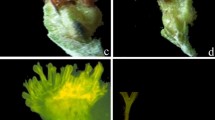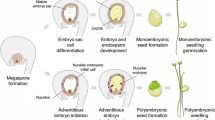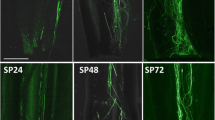Abstract
Artemisia annua L. is the only natural resource that produces artemisinin (Qinghaosu), an endoperoxide sesquiterpene lactone used in the artemisinin-combination therapy of malaria. The cross-hybridization properties of A. annua do not favor studying artemisinin biosynthesis. To overcome this problem, in this study, we report on selection of self-pollinated A. annua plants and characterize their development and artemisinin biosynthesis. Self-pollinated F2 plants selected were grown under optimized growth conditions, consisting of long day (16 h of light) and short day (9 h of light) exposures in a phytotron. The life cycles of these plants were approximately 3 months long, and final heights of 30–35 cm were achieved. The leaves on the main stems exhibited obvious morphological changes, from indented single leaves to odd, pinnately compound leaves. Leaves and flowers formed glandular and T-shaped trichomes on their surfaces. The glandular trichome densities increased from the bottom to the top leaves. High performance liquid chromatography–mass spectrometry-based metabolic profiling analyses showed that leaves, flowers, and young seedlings of F2 plants produced artemisinin. In leaves, the levels of artemisinin increased from the bottom to the top of the plants, showing a positive correlation to the density increase of glandular trichomes. RT-PCR analysis showed that progeny of self-pollinated plants expressed the amorpha-4, 11-diene synthase (ADS) and cytochrome P450 monooxygenase 71 AV1 (CYP71AV1) genes, which are involved in artemisinin biosynthesis in leaves and flowers. The use of self-pollinated A. annua plants will be a valuable approach to the study of artemisinin biosynthesis.








Similar content being viewed by others
Abbreviations
- ADS:
-
Amorpha-4, 11-diene
- CYP71AV1:
-
Cytochrome P450 monooxygenase 71 AV1
- HPLC–ESI–MS:
-
High performance liquid chromatography–electron spray ionization–mass spectrometry
- MS:
-
Murashige and Skoog
- QHS:
-
Qinghaosu
References
Acton N, Klayman DL (1985) Artemisitene, a new sesquiterpene lactone endoperoxide from Artemisia annua. Planta Med 51:441–442
Bouwmeester HJ, Wallaart TE, Janssen MHA, van Loo B, Jansen BJM, Posthumus MA, Schmidt CO, De Kraker J-W, Konig WA, Franssen MCR (1999) Amorpha-4, 11-diene synthase catalyses the first probable step in artemisinin biosynthesis. Phytochemistry 52:843–854
Chang Y-J, Song S-H, Park S-H, Kim S-U (2000) Amorpha-4, 11-diene synthase of Artemisia annua: cDNA isolation and bacterial expression of a terpene synthase Involved in artemisinin biosynthesis. Arch Biochem Biophys 383:178–184
Covello PS, Teoh KH, Polichuk DR, Reed DW, Nowak G (2007) Functional genomics and the biosynthesis of artemisinin. Phytochemistry 68:1864–1971
Delabays N, Benakis A, Collet G (1993) Selection and breeding for high artemisinin (qinghaosu) yielding strains of Artemisia annua. Acta Horticult 330:203–207
Delabays N, Simonnet X, Gaudin M (2001) The genetics of artemisinin content in Artemisia annua L. and the breeding of high yielding cultivars. Curr Med Chem 8:1795–1801
Duke SO, Vaughn KC, Croom EM Jr, Elsohly HN (1987) Artemisinin, a constituent of annual wormwood (Artemisia annua), is a selective phytotoxin. Weed Sci 35:499–505
Duke MV, Paul RN, Elsohly HN, Sturtz G, Duke SO (1994) Localization of artemisinin and artemisitene in foliar tissues of glanded and glandless biotypes of Artemisia annua L. Int J Plant Sci 155:365–372
Ferreira JFS, Janick J (1995) Floral morphology of Artemisia annua with special reference to trichomes. Int J Plant Sci 156:807–815
Ferreira JFS, Simon JE, Janick J (1995) Developmental studies of Artemisia annua: Flowering and artemisinin production under greenhouse and field conditions. Planta Med 61:167–170
Ferreira JFS, Laughlin JC, Delabays N, Magalhães PMd (2005) Cultivation and genetics of Artemisia annua L. for increased production of the antimalarial artemisinin. In: Koebner R (ed) Plant Genetic Resources. Cambridge University Press, Cambridge, pp 206–229
Graham IA, Besser K, Blumer S, Branigan CA, Czechowski T, Elias L, Guterman I, Harvey D, Isaac PG, Khan AM, Larson TR, Li Y, Pawson T, Penfield T, Rae AM, Rathbone DA, Reid S, Ross J, Smallwood MF, Segura V, Townsend T, Vyas D, Winzer T, Bowles D (2010) The genetic map of Artemisia annua L. identifies loci affecting yield of the antimalarial drug artemisinin. Science 327:328–331
Kim S-H, Chang Y-J, Kim S-U (2008) Tissue specificity and developmental pattern of amorpha-4, 11-diene synthase (ADS) proved by ADS promoter-driven GUS expression in the heterologous plant, Arabidopsis thaliana. Planta Med 74:188–193
Klayman DL, Lin AJ, Acton N, Scovill JP, Hoch JM, Milhous WK, Theoharides AD, Dobek AS (1984) Isolation of artemisinin (Qinghaosu) from Artemisia annua growing in the United States. J Nat Prod 47:715–717
Liersch R, Soicke H, Stehr C, Tüllner H-U (1986) Formation of artemisinin in Artemisia annua during one vegetation period. Planta Med 52:387–390
Liu J-M, Ni M-Y, Fan J-F, Tu Y-Y, Wu Z-H, Wu Y-L, Chou W-S (1979) Structure and reaction of arteannuin. Acta Chim Sin 37:129–143
Liu C, Zhao Y, Wang Y (2006) Artemisinin: current state and perspectives for biotechnological production of an antimalarial drug. Appl Microbiol Biotechnol 72:11–20
Lommen WJ, Schenk E, Bouwmeester HJ, Verstappen FW (2005) Trichome dynamics and artemisinin accumulation during development and senescence of Artemisia annua leaves. Planta Med 71:336
Lommen WJM, Elzinga S, Verstappen FWA, Bouwmeester HJ (2007) Artemisinin and sesquiterpene precursors in dead and green leaves of Artemisia annua L. crops. Planta Med 73:1133–1139
Martin VJJ, Pitera DJ, Withers ST, Newman JD, Keasling JD (2003) Engineering a mevalonate pathway in Escherichia coli for production of terpenoids. Nat Biotech 21:796–802
Mercke P, Bengtsson M, Bouwmeester HJ, Posthumus MA, Brodelius PE (2000) Molecular cloning, expression, and characterization of amorpha-4, 11-diene synthase, a key enzyme of artemisinin biosynthesis in Artemisia annua L. Arch Biochem Biophys 381:173–180
Murashige T, Skoog F (1962) A revised medium for rapid growth and bioassays with tobacco tissue culture. Physiol Plant 15:473–497
Peter-Blanc C (1992) Developpement et biologie de la reproduction de l’Artemisia annua L. Travail de diplome. Université de Lausanne, Suisse
Ro D-K, Paradise EM, Ouellet M, Fisher KJ, Newman KL, Ndungu JM, Ho KA, Eachus RA, Ham TS, Kirby J, Chang MCY, Withers ST, Shiba Y, Sarpong R, Keasling JD (2006) Production of the antimalarial drug precursor artemisinic acid in engineered yeast. Nature 440:940–943
Saravitz CH, Downs RJ, Thomas JF (2009) PHYTOTRON PROCEDURAL MANUAL: For Controlled-Environment Research at the Southeastern Plant Environment Laboratory. http://www.ncsu.edu/phytotron/manual.pdf
Smith LMJ, Bentley S, Jones H, Burns C, Arroo RRJ, Woolley JG (2010) Developing an alternative UK industrial crop Artemisia annua, for the extraction of artemisinin to treat multi-drug resistant malaria. Asp Appl Biol 101:99–106
Tellez MR, Canel C, Rimando AM, Duke SO (1999) Differential accumulation of isoprenoids in glanded and glandless Artemisia annua L. Phytochemistry 52:1035–1040
Teoh KH, Polichuk DR, Reed DW, Nowak G, Covello PS (2006) Artemisia annua L. (Asteraceae) trichome-specific cDNAs reveal CYP71AV1, a cytochrome P450 with a key role in the biosynthesis of the antimalarial sesquiterpene lactone artemisinin. FEBS Lett 580:1411–1416
Teoh KH, Polichuk DR, Reed DW, Covello PS (2009) Molecular cloning of an aldehyde dehydrogenase implicated in artemisinin biosynthesis in Artemisia annua. Botany 87:635–642
Tu Y-y, Ni M-y, Zhong Y-r, Li L-n, Cui S-l, Zhang M-q, Wang X-z, Ji Z, Xiao-tian L (1982) Studies on the constituents of Artemisia annua Part II. Planta Med 44:114–143
Wallaart TE, Pras N, Quax WJ (1999) Seasonal variations of artemisinin and its biosynthetic precursors in tetraploid Artemisia annua plants compared with the diploid wild-type. Planta Med 65:723–728
Wallaart TE, Pras N, Beekman AC, Quax WJ (2000) Seasonal variation of artemisinin and its biosynthetic precursors in plants of Artemisia annua of different geographical origin: proof for the existence of chemotypes. Planta Med 66:57–62
Wallaart TE, Bouwmeester HJ, Hille J, Poppinga L, Maijers NCA (2001) Amorpha-4, 11-diene synthase: cloning and functional expression of a key enzyme in the biosynthetic pathway of the novel antimalarial drug artemisinin. Planta 212:460–465
Wang W, Wang Y, Zhang Q, Qi Y, Guo D (2009) Global characterization of Artemisia annua glandular trichome transcriptome using 454 pyrosequencing. BMC Genomics 10:465
Weathers P, Elkholy S, Wobbe K (2006) Artemisinin: The biosynthetic pathway and its regulation in Artemisia annua, a terpenoid-rich species. In Vitro Cell Dev Biol Plant 42:309
WHO (1998) Artemisinin and its derivatives as anti-malarial drugs. Artemisinin and its Derivatives as Anti-Malarial Drugs, Geneva
WHO (2005) Meeting on the production of artemisinin and artemisinin-based combination therapies, 6–7 June 2005, Arusha, United Republic Tanzania
WHO (2009a) Impact of malaria control. World Malaria Report 2009, Geneva, pp 27–44
WHO (2009b) Interventions to control malaria. World Malaria Report 2009. World Health Organization, Geneva, pp 9–26
WHO (2009c) Polices, stratagies adn targets for malaria control. World Malaria Report 2009, Geneva
WHO (2010) Good procurement practices for artemisinin-based antimalarial medicines. WHO Global Malaria Programme
Xie D-Y, Kang N-l, Li G-z (1995) Studies on the karyotype of Artemisia annua. Chin Bull Botany 12(Supplement):71–72
Zhang Y, Teoh KH, Reed DW, Maes L, Goossens A, Olson DJH, Ross ARS, Covello PS (2008) The molecular cloning of artemisinic aldehyde u11(13) reductase and its role in glandular trichome-dependent biosynthesis of artemisinin in Artemisia annua. J Biol Chem 283:21501–21508
Zhang Y, Nowak G, Reed DW, Covello PS (2010) The production of artemisinin precursors in tobacco. Plant Biotechnol J. doi:10.1111/j.1467-7652.2010.00556.x (in press)
Zhong-Yi-Yan-Jiu-Yue-Zhong-Yao-Yan-Jiu-Suo (1978) Qing Hao Kang Nue Yan Jiu:1971-1978 (Antimalarial studies of Artemisia annua L:1971–1978). Zhong Yi Yan Jiu Yue Zhong Yao Yan Jiu Suo
Acknowledgments
We thank the North Carolina Biotechnology Center for providing this research grant (Grant #55031) to support the genetic engineering of the artemisinin research. We give our special gratitude to Dr. George Yatskievych from Missouri Herbarium at Missouri Botanical Garden for his kind help to collect Artemisia annua seeds. We thank Dr. Valerie Knowlton from the Center for Electron Microscopy for her kind help in preparing the SEM.
Author information
Authors and Affiliations
Corresponding author
Electronic supplementary material
Below is the link to the electronic supplementary material.
Rights and permissions
About this article
Cite this article
Alejos-Gonzalez, F., Qu, G., Zhou, LL. et al. Characterization of development and artemisinin biosynthesis in self-pollinated Artemisia annua plants. Planta 234, 685–697 (2011). https://doi.org/10.1007/s00425-011-1430-z
Received:
Accepted:
Published:
Issue Date:
DOI: https://doi.org/10.1007/s00425-011-1430-z




